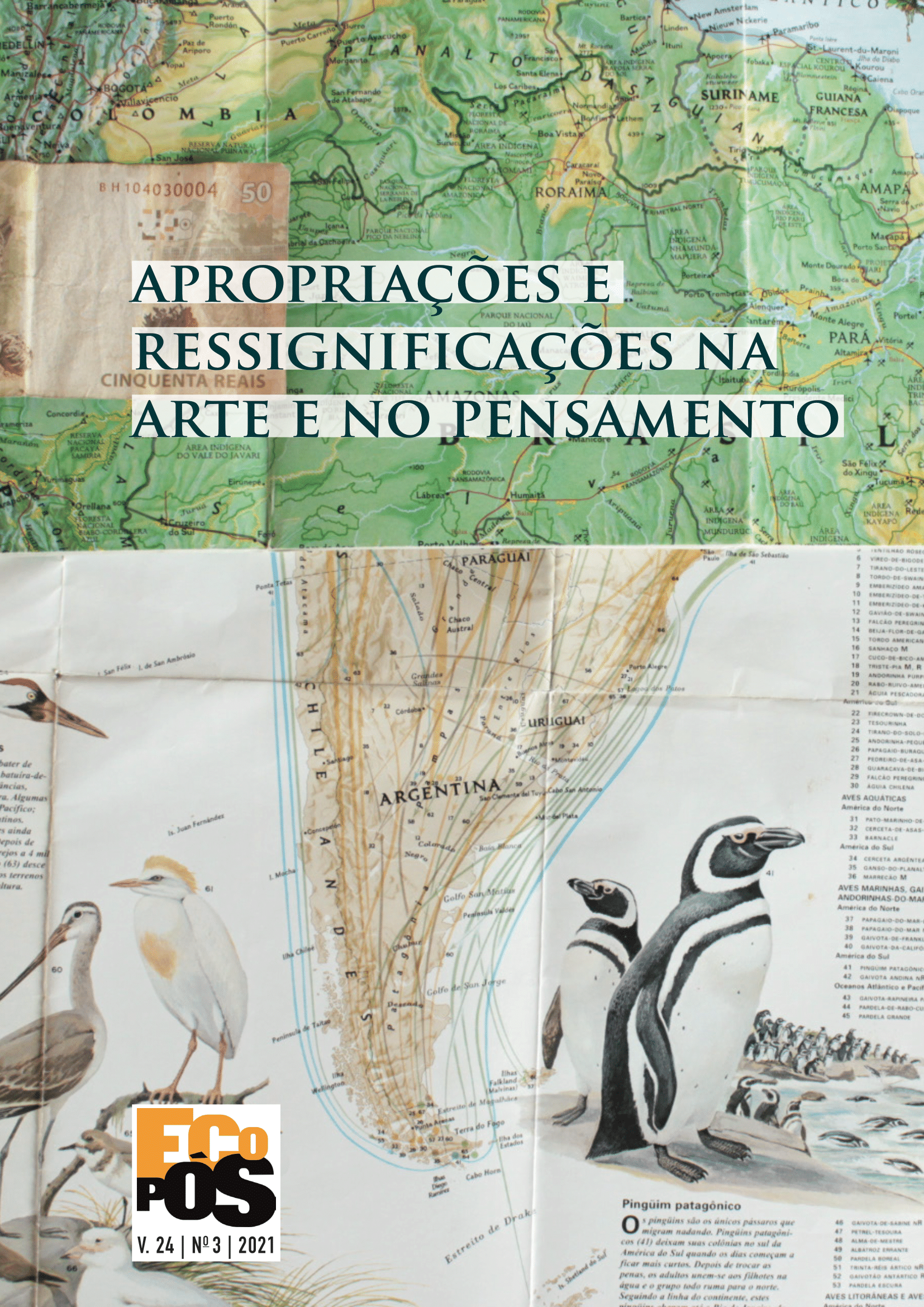Montagem e apropriação no cinema de John Akomfrah
DOI:
https://doi.org/10.29146/ecopos.v24i3.27766Keywords:
Keywords: Black cinema; essay film; archive; African diasporaAbstract
Abstract: This paper examines the dynamics of the reuse of archival materials in John Akomfrah's cinema. I argue that editing takes on an essayistic vein in his work, embodying a “cinema of ideas”, while admitting a relative autonomy of the appropriated images. This second movement is based on the artist's recognition that the indexical root of the filmic image would be in part irreducible to the chains of discourse. This proposition is supported by an analysis of the film Handsworth Songs (1986), in which Akomfrah brings into dialogue the racial uprisings then underway in Thatcherite England and the aspirations of West Indian emigrants in post-war Britain.
Keywords: Black cinema; essay film; archive; African diaspora
Downloads
References
AKOMFRAH, J. “John Akomfrah by Shezad Dawood”. Entrevista concedida a Shezad Dawood. Bomb Magazine, Nova York, 19 jun. 2018a. Disponível em: <https://bombmagazine.org/articles/john-akomfrah/>. Acesso em: 06/09 2021.
AKOMFRAH, J. John Akomfrah. Entrevista concedida a Saha Birukova. Artecapital, Lisboa, 6 nov. 2018b. Disponível em: <https://www.artecapital.net/entrevista-269-john-akomfrah>. Acesso em: 06/09 2021.
AKOMFRAH, J. John Akomfrah. In: CAREY-THOMAS, L. Migrations: Journeys into British Art. Londres: Tate Britain, 2012.
AMIEL, V. Estética da montagem. Lisboa: Texto & Grafia, 2007.
Bailey, D; Hall, S. (2003), ‘The Vertigo of Displacement’, in L. Wells (ed.), The Photography Reader, London: Routledge.
BARTHES, R. A câmara clara: nota sobre a fotografia. Rio de Janeiro: Nova Fronteira, 1984.
BARTHES, R. O óbvio e o obtuso: ensaios críticos. v. 3. Rio de Janeiro: Nova Fronteira, 1990.
BENSE, M. On the Essay and its Prose. In: ALTER, N; CORRIGAN, T. (Orgs.) Essays on the Essay Film. New York: Columbia University Press, 2017.
CLIFFORD, J. Routes: Travel and translation in the late twentieth century. Cambridge: Harvard University Press, 1997.
COMOLLI, J. Ver e poder: a inocência perdida: cinema, televisão, ficção, documentário. Belo Horizonte: UFMG, 2008.
COMOLLI, J. Documento y espectáculo. In: CAPDEVILA, Ester (org.). Ideas Recibidas. Barcelona: Macba, 2012.
EISENSTEIN, S. A forma do filme. Rio de Janeiro: Zahar, 1990.
ESHUN, K. Drawing the forms of Things Unknown. In: ESHUN, K; SAGAR, A. The Ghosts of Songs: The Film Art of the Black Audio Film Collective. Liverpool: Liverpool University Press, 2007
HALL, S. A identidade cultural na pós-modernidade. Rio de Janeiro: DP&A, 2006.
HALL, S. The young Englanders. London: National Committee for Commonwealth Immigrants, 1967.
HARRIS, W. The womb of space: the cross-cultural imagination. Westport: Greenwood Press, 1983.
LUKACS, G. Sobre a essência e a forma do ensaio: carta a Leo Popper. Revista Serrote, Rio de Janeiro: IMS, n. 18, p. 42, 2014.
MARKS, L. The skin of the film. Durham: Duke University Press, 2000.
NAFICY, H. The making of exile cultures: Iranian television in Los Angeles. Minneapolis: University of Minnesota Press, 1993.
OLUSOGA, D. Black and British: A forgotten history. Londres: Pan Macmillan, 2016.
RANCIÈRE, J. Figures of History. Cambridge, UK; Malden, Mass: Polity, 2014.
RANCIÈRE, J. The intervals of cinema. Nova York: Verso, 2019.
RUSSELL, C. Archiveology: Walter Benjamin and Archival Film Practices. Durham: Duke University Press, 2018.
Downloads
Published
How to Cite
Issue
Section
License
Copyright (c) 2021 Revista ECO-Pós

This work is licensed under a Creative Commons Attribution 4.0 International License.
Aos autores pertence o direito exclusivo de utilização ou reprodução.
Você tem o direito de:
- Compartilhar — copie e redistribua o material em qualquer meio ou formato.
- Adaptar — remixar, transformar e construir sobre o material para qualquer filme, mesmo comercial.
O licenciante não pode revogar esses direitos, desde que você respeite os termos da licença.
De acordo com os seguintes termos:
- Atribuição — Você deve dar o devido crédito, fornecer um link para a licença e indicar se essas alterações foram feitas. Você pode fazê-lo de qualquer maneira razoável, mas não de maneira que sugira que o licenciante endosse ou aprove seu uso.
- Sem restrições adicionais — Você não pode aplicar termos legais ou medidas de natureza tecnológica que restrinjam legalmente outros de fazer algo que a licença permite.
Aviso: A licença pode não fornecer todas as permissões necessárias para o uso pretendido. Por exemplo, outros direitos, como publicidade, privacidade ou direitos morais, podem limitar a maneira como você usa o material.











